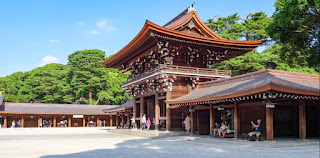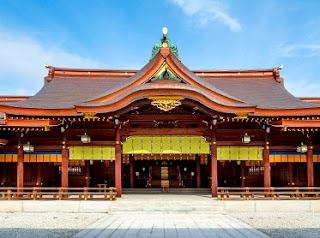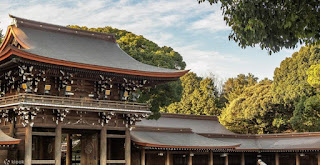Meiji Shrine
Certainly, let's delve deeper into the details of Meiji Shrine, exploring its history, significance, architecture, rituals, and more:
History :
Meiji Shrine was established in 1920 to honor Emperor Meiji and Empress Shoken. Emperor Meiji's reign marked a transformative period in Japanese history known as the Meiji Restoration (1868-1912), during which Japan underwent modernization and opened up to the world.
The shrine was constructed on a site where the emperor and empress were enshrined after their deaths. The funds for the shrine's construction were raised through a public fundraising campaign.
Architecture:
The shrine's architectural style is characteristic of Shinto shrines, emphasizing simplicity and harmony with nature.
The main hall, or honden, is constructed using traditional materials like cypress wood and copper. The thatched roof and unpainted wood evoke a sense of historical authenticity.
The inner precinct features various structures, including the main hall, the treasure house, and the Meiji Memorial Picture Gallery.
Rituals and Practices:
Shinto rituals at Meiji Shrine are centered around paying respects to the deities enshrined there and seeking their blessings for various aspects of life.
Visitors often follow a specific sequence when visiting the shrine: bow twice, clap twice, make a wish or prayer in silence, and then bow once more. This sequence shows respect to the deities.
Ema : Wooden plaques where visitors write their wishes or prayers. These plaques are then hung on designated boards within the shrine grounds.
Omikuji : Fortune-telling slips that offer insights into one's fortune. If the fortune is unfavorable, visitors tie it to a tree or rope on the shrine grounds to leave the bad luck behind.
Nature and Environment:
The shrine is surrounded by a lush forest called the Meiji Jingu Inner Precinct, covering an area of about 170 acres. It was intentionally designed to create a peaceful sanctuary in the midst of the bustling city.
The forest contains approximately 120,000 trees of various species, many of which were donated by people from all over Japan during the shrine's construction.
Cultural Significance:
Meiji Shrine holds deep cultural significance as a place of remembrance for Emperor Meiji, who played a crucial role in Japan's transformation from a feudal society to a modern nation.
The shrine's architecture and serene environment make it a popular destination for both tourists and locals seeking a spiritual and tranquil experience within Tokyo.
Festivals and Events:
The shrine hosts several annual festivals, including the Spring Grand Festival (Haru Matsuri) in late April and the Autumn Grand Festival (Aki Matsuri) in early November.
These festivals feature traditional Shinto ceremonies, performances of ancient music and dance, and processions of priests and shrine maidens in colorful attire.
Meiji Shrine's cultural and historical significance, along with its serene forest setting, make it a remarkable place where visitors can connect with Japan's traditions, pay their respects to the past, and find solace amidst the city's modernity.
Attractions:
Torii Gate: The entrance to Meiji Shrine is marked by a massive torii gate made of cypress wood. It's an iconic symbol of the shrine and the transition from the modern city to the tranquil forest within.
Forest Path: As you walk from the torii gate toward the main shrine buildings, you'll follow a peaceful path through a dense forest, offering a serene escape from the city's hustle and bustle.
Main Shrine Buildings: The main shrine structures are characterized by their simplicity and traditional Shinto architectural style. They are made of cypress and copper.
Inner Garden: The inner garden, located near the shrine complex, is a beautiful area with a pond and walking paths. It's a serene space to enjoy nature and tranquility.
Meiji Memorial Picture Gallery: This gallery showcases photographs of Emperor Meiji and Empress Shoken's lives, providing insights into their contributions to Japan's modernization.
Ema and Omikuji: Visitors can write their wishes on wooden plaques called "ema" and tie them to designated areas within the shrine. They can also draw omikuji (fortune-telling slips) to learn about their fortunes.
Facts:
New Year's Celebrations: Meiji Shrine is a popular destination for hatsumode, the first shrine visit of the New Year. Thousands of people come to offer their prayers and wishes during this time.
Weddings: The shrine is a popular venue for traditional Shinto weddings. The bride and groom, dressed in traditional attire, often participate in a procession through the forest to the main hall.
Sake Barrels: At the entrance of the shrine, you'll find rows of sake barrels. These barrels are donations from sake breweries and are offered to the deities during special ceremonies.
Spring Festivals: Meiji Shrine hosts various festivals throughout the year, including the Spring Grand Festival and Autumn Grand Festival. These events feature traditional performances and rituals.
Nature Conservation: The forest surrounding the shrine, known as Meiji Jingu Inner Precinct, is an oasis of biodiversity within the city. It's maintained through the efforts of dedicated staff and volunteers.
Meiji Shrine offers a serene and culturally significant experience, allowing visitors to connect with Japan's history, spirituality, and natural beauty. It's a place of reverence and reflection amid the urban landscape of Tokyo.





0 Comments